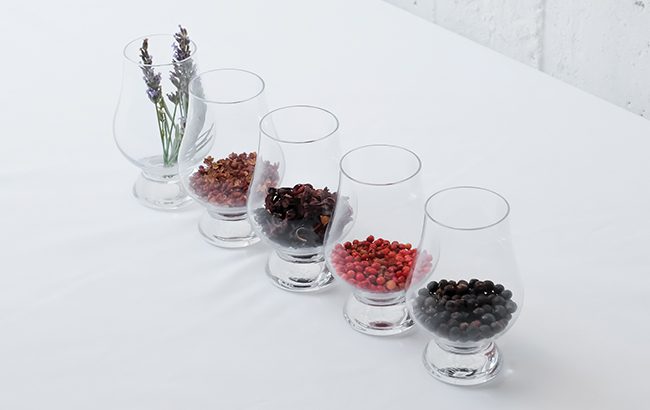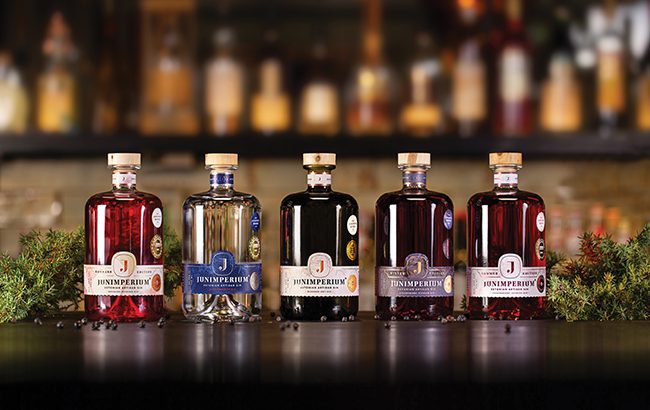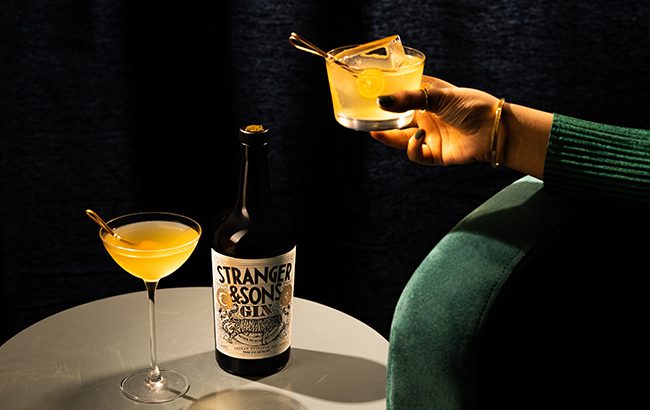The gin brands championing local ingredients
By Clinton CawoodAway from the traditional heartlands of gin, producers are creating a buzz by focusing on local ingredients.

*This feature was first published in the December 2022 issue of The Spirits Business magazine.
It might be difficult to imagine in these gin-abundant days, but there was a time when this ubiquitous spirit was predominantly made in just a handful of places, and hardly anyone ever asked where a particular brand was from. Today there isn’t a corner of the globe, it seems, where you won’t find a craft distiller producing their own local version.
For producers in countries that aren’t traditionally associated with gin production, place of origin has its pros and cons. These brands make use of their provenance in a variety of ways, some putting it at the core of their story, while others highlight other aspects, such as their production process or the botanicals used.
Among those in the first camp is India’s Stranger & Sons. Kunal Chopra, head of marketing and innovation at Third Eye Distillery, explains: “Stranger & Sons is a brand born in contemporary India and designed to celebrate it. As early innovators in the Indian gin landscape, we wanted to reinvent the perception of the Indian spirits industry while at the same time encouraging consumers towards exploring spirits through more creative, experimental choices.”
Untapped flavours
Another Indian gin putting its provenance front and centre is Hapusa, which places a particular focus on its local ingredients. “When we created India’s first craft gin, we had a massive reservoir of untapped flavours to work with, considering we happen to be in the spice capital of the world,” says Anand Virmani, founder, CEO and distiller at parent company Nao Spirits & Beverages. “We were able to find flavours that are almost never found in gins around the world.”
Being from India has helped Hapusa to stand out in a crowded market. “Since India is a country that hasn’t produced too many brands of gin, there is certainly a place for our bottles in most collections,” says Virmani.
Brazil’s Vitoria Regia Organic Gin takes a hybrid approach when it comes to incorporating its origins into its story. With owners that are Brazilian and British, the brand draws on both influences, even down to its name, which refers to both an Amazonian lily pad and to Queen Victoria. As Hamilton Lowe, co‐founder and CMO of parent company Carmosina Holdings, puts it: “Vitoria Regia Organic Gin was conceived out of blending a predominantly British category with the true soul and flavours of Brazil.”
There are a number of benefits for the brand, believes Lowe. “Having such a cluttered market it helps us stand out,” he says. “The flavour profile is original, and offers something genuinely different compared with the many high‐quality British gins on the market.”

Fellow Brazilian gin Amázzoni benefits from its provenance in various ways, from its story to the liquid itself, according to founder Arturo Isola. “There is the appeal of Brazil as the origin country – one that is friendly and inclusive,” he says, adding that the country has influenced the gin’s flavour profile too. “We would have never reached the quality of our liquid if we hadn’t had access to the richness and vastness of the nature that surrounds us.”
Moving to Africa, Kenyan gin Procera not only draws on its country of origin, but more broadly from its continent. As brand manager and co‐owner Ivan Dixon confirms: “Country and continent of origin are pivotally important to Procera in all aspects of brand messaging, from the name and bottle design, through to the flavour profile of our liquid.”
Significant benefits
The benefits when it comes to the liquid itself are particularly significant for Procera co-founder and CEO Guy Brennan. “It also allows us to break the rules, as we are not so bound by them,” he says. “Not having legacy traditions allows for innovations to flourish.”
As with so many other gin brands from lesser‐known producing countries, there’s also a sense of being part of something greater, and leading the way for other local distilleries. “We want Procera to be as authentically African as possible, and see African gin as an emerging sub‐category,” says Dixon.
Procera’s broader focus on its continent highlights an advantage for gins such as these to draw on a broader pool of influences. Another looking to its continent for inspiration and story, rather than just a single country, is The Orientalist Spirits. The company’s range includes Gunpowder Gin, a contemporary gin produced using a blend of traditional and low‐temperature vacuum distillation techniques. “The brand is all about Asia, but the unexpected side,” says founder Michel Lu. “We strive to create cues through marketing, packaging and flavours that bring to life the lesser‐known aspects of Asian culture. For example, our label captures Asian art and culture, and as the first truly pan‐ Asian spirit, we aspire to showcase the flavours of the liquid through the design.”
There are those who take a comparatively nuanced approach to incorporating their provenance into their brand, such as Kyrö Distillery Company in Finland. “The country of origin is not as important as our local environment, culture, and community,” says Miika Lipiäinen, co‐founder of Kyrö Distillery Company.

Junimperium Distillery in Finland is another that doesn’t put its country at the centre of its brand. “The most important factor is the product itself. If the product is on the highest quality level, multi‐awarded, innovative and interesting, then where it comes from isn’t so important.
“You have to concentrate on the product, and the origin comes after that,” says cofounder Tarvo Jaansoo. “We make international gins with a touch of local Estonian nature.”
For UK‐based Distilled Brands, which includes Junimperium in its portfolio, the marketing focus is on the style of gin that results from its country of origin, rather than the place itself. “It allows us to position Junimperium Gin as a super‐premium offer in the category of world’s best gins, where bars or retailers offer gin from the world stage for consumers who are keen to try different styles,” says managing partner Gary Hazell.
Another company focusing on other aspects of the brand, with country just one component, is The Ethical Spirits & Co in Japan. “Our main theme is ‘ethical’. We don’t focus on the fact that we are a Japanese brand,” says CEO Yuya Yamamoto. “When we communicate with customers, they are interested in the fact that we are ethical, as we are upcycling the botanicals and saké lees. Next to that, they will notice that our products are using some unique ingredients, and know that we are from Japan.”
Whether country of origin is front and centre, or a more subtle component of a brand, there are various approaches when it comes to communicating this, and to some extent, being from a country not immediately associated with gin allows for creative freedom in this regard.
For Procera, there are a number of ways to communicate its African origins, from details of its packaging to tastings that highlight botanicals sourced from the continent. “We also use a wealth of beautiful Kenyan imagery in our marketing, which captures the flavour of our unique origin, and helps explain our sustainable and environmental principles,” says Dixon.
Virmani recognises the potential to communicate something new with Hapusa, not only going beyond traditional gin marketing, but communicating something unexpected about the country too. “India has such a strong character and stereotypes associated with it that it’s very easy and tempting to fall into one of those buckets. Instead, we have tried to carve our own path by talking about the botanicals, the people, the gin, and the modern contexts in which all of these elements exist together.”

Stranger & Sons, meanwhile, adopts an experiential approach. “While our botanicals play a crucial role in our communication, it goes beyond this, as our gin truly represents the spirit of India, in a spirit from India,” explains Chopra. “We bring this to life through our curated experiences that, much like the country it’s inspired by, are dynamic, bold, layered and just a bit strange.”
Lu sees the potential to broaden consumers’ horizons with The Orientalist Spirits, and its Gunpowder Gin. “From a marketing perspective, we have to be bold and brave to ensure we capture consumers who may be sceptical trying a gin produced from an unexpected region.”
Virmani recognises the challenges of offering a gin from a country not already associated with gin‐producing expertise. “There might be a need to prove one’s credentials as a capable gin producer if you’re coming from a fairly new country on the world gin map, but I think that is easily surmountable,” he says.
Speaking stylistically, not having an established tradition of gin production can be a double‐edged sword, says Kyrö’s Lipiäinen. “We don’t have a historically defined style, geographical indicators or a lot of existing demand specifically for gin from our country or region. But on the other hand, these same things are an advantage. We get to define our own style, and people are really curious to find out more about it.”
And then there are existing associations with local spirits to take into account, both domestically and when looking to export markets. “Brazil is the land of cachaça, and for as long as anyone can remember, if you were asking for a cocktail, the answer was just one option: Caipirinha,” says Isola. “But being a pioneer will always be a positive.”
With its abundance of pioneers, now spanning the globe, it’s no surprise that gin continues to be such a vibrant and compelling category.
Related news
Crafter’s launches citrus gin for GTR
